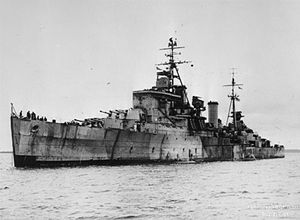HMS Swiftsure (08)
 |
|
| History | |
|---|---|
|
|
|
| Name: | HMS Swiftsure |
| Builder: | Vickers Armstrong at Newcastle-on-Tyne |
| Laid down: | 22 September 1941 |
| Launched: | 4 February 1943 |
| Commissioned: | 22 June 1944 |
| Decommissioned: | 1958 |
| Identification: | Pennant number: 08 |
| Fate: | Scrapped 1962 |
| General characteristics | |
| Class and type: | Minotaur-class light cruiser |
| Displacement: |
|
| Length: | 555.5 ft (169.3 m) |
| Beam: | 63 ft (19 m) |
| Draught: | 17.25 ft (5.26 m) |
| Propulsion: |
|
| Speed: | 31.5 kn (58.3 km/h; 36.2 mph) |
| Range: |
|
| Complement: | 867 |
| Armament: |
|
| Armour: | |
HMS Swiftsure was a Minotaur-class light cruiser of the Royal Navy. She was laid down by Vickers Armstrong at Newcastle-on-Tyne on 22 September 1941, launched on 4 February 1943 by Lady Wake-Walker and commissioned on 22 June 1944. The first of a new Minotaur class, a development of the later Colony class with extra beam and a fifth twin 4 inch turret. Swiftsure was the last Royal Navy cruiser completed during World War Two and was the first British cruiser designed around the concept of an operations room and modern radar, with sensor screens and communications positioned for efficient operation. In 1945 in the Pacific, she proved the most efficient anti-aircraft cruiser in the fleet and was the first Royal Navy cruiser with the 274 lock-and-follow radar targeting for her main armament
Swiftsure joined the Home Fleet on commissioning, and in 1944 she was assigned to the Eastern Fleet, where, in November 1944, she became a unit of the newly formed British Pacific Fleet. In the Pacific she participated in the Okinawa Campaign of March–May 1945 and in June took part in the carrier raid on Truk by the British Pacific Fleet as part of Task Group 111.2, with the cruisers shelling the islands. On 30 August 1945 this group re-entered Hong Kong and took the Japanese surrender there. Swiftsure was at this time the flagship of the British Pacific Cruiser Squadron, and was selected by Admiral Cecil Harcourt to hoist his flag for the Japanese surrender.
In 1946 she was the flagship of the 4th Cruiser Squadron and in 1951 she became the flagship of the 2nd Cruiser Squadron. Swiftsure was updated for commonality with HMS Superb with 3 glasshouse DC with 275 radar for the 4-inch guns, 960M LRAW and a more powerful 40 mm light AA of Boffin and Buster mounts. In 1953 she took part in the Fleet Review to celebrate the Coronation of Queen Elizabeth II. In the same year she was involved in a collision with the destroyer Diamond, which led to a fierce fire in the forward paint locker. She remained inactive until beginning a major refit in February 1957 Chatham Dockyard to bring her up largely to the standard of the later Tiger class. New 70 calibre twin 3-inch guns and L70 Bofors would have been fitted, but Swiftsure would have retained her original triple 6 inch turrets. Midway through the conversion in August 1959, with her new bridge and lattice masts in place, the refit was cancelled. Some reports and the government reply in 1962 in UK Hansard say the refit was costing too much to produce an obsolete ship, Original estimates for the refit in 1956 had been 4 million pounds The damage suffered during her earlier collision with Diamond was not fully surveyed and only became apparent during the refit, which delayed the modernisation, which had been scheduled for completion in December 1959, and after expenditure of more than 1 million pounds and facing far higher dockyard labour and material costs, modernisation as a gun cruiser was abandoned, although in a rare April 1960 photo of Swiftsure at Chatham dockyard the three 161-ton Mk 23 turrets (483 tons) are reinstalled and the reconstruction is clearly, partially complete, suggesting the rebuilt hull, had sufficient strength Even with the 6 channel AA fire control system, planned for Swiftsure, which combined, 40 mm and 4-inch fire against specific targets, the twin 4-inch X1X turret updated with roof mounted, tracking radar (as on the cruiser Bermuda and the aircraft carrier Victorious twin 3-inch gun turrets) they were still slow firing, manual and inaccurate. Obsolete, compared with the twin 3-inch, or stabilised, enclosed Sverdlov 4 in (105 mm) AA guns, or even single Mk 5, 55 degree elevation 4.5-inch guns refitted on the C and Type 81 classes from 1955. The Mk 5 twin 40 mm CIWS batteries were heavy and required too many ratings to maintain. Pre Falkland war experience, they were irrelevant to the expected scenarios of missile, standoff and high level attack. 1959 saw the last fittings of multiple Type 262 radar controlled Mk 5 mounts on Hermes and Belfast.
...
Wikipedia
